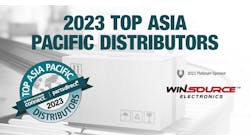Professionals on the front lines of electronics manufacturing are telling us something positive: that business is returning to the strategies (and uncertainties) we know and, with that, the fears of economic fluctuations are fading. At least that's what Smith & Associate's latest survey indicates.
To stay on top of industry shifts and views on the global supply chain, Smith & Associates conducts an annual survey representing the major industry sectors and job functions. The full survey report covers component demand trends and forecasts, counterfeit vulnerabilities, and sustainability management, and there are some interesting perspectives regarding key challenges, concerns, and services that are worth highlighting.
Gauging Key Challenges Along the Global Supply Chain
We asked survey respondents to rank their top supply chain challenges. This year's top-rated concern was changes in demand—a concern that ranked second last year behind economic fluctuations.
The drill down on this is interesting. In rating the top challenges to forecasting and planning, there is near uniformity among original equipment manufacturers (OEMs), electronics manufacturing services (EMS) providers, contract manufacturers (CMs), and original design manufacturers (ODMs) in listing demand changes (an average of 72% of respondents) as the top-most challenge, followed by inventory management issues (47%) and margin pressures and cost-efficiencies (42%). Distributors were the only group to have rated margin pressures and cost-efficiencies as the greatest challenge, followed by demand changes and then economic changes and uncertainty. No other group rated economic changes in the top three this year.
The shift in responses between last year's and this year's survey shows that economic changes and uncertainty (37.5%) dropped in rating as did supplier consolidations (14%). When viewed with the improved macro-economic situation and growing consumer confidence, we consider this finding to signal a positive trend. The reason we see this shift as important is because demand changes are normal. They are an inherent characteristic of our growing industry, whereas economic changes and uncertainty are negative external pressures that hamper growth.
To ensure the validity of the responses to this question, we also asked the inverse—namely, what issues DO NOT pose challenges to regular supply chain forecasting or planning. The responses show a significant difference based on the type of company, reminding us of the differences in challenges and views of the global supply chain depending on what role or function a company holds (distributor versus contract manufacturer or OEM). For example, 63% of distributors place supplier consolidations and mergers & acquisitions (M&A) as the least challenging issues followed by regulatory certification changes (47%). The converse is true for EMS providers, with a 46% and 65% rating, respectively. For CMs, ODMs, and OEMs, the split is more evenly distributed between these two least challenging issues.
Evaluating Service Needs to Address Challenges
To explore solutions to supply chain challenges, we posed another question to evaluate the importance of services provided by independent distributors, such as Smith & Associates. Of course, this question served multiple purposes for us, but one aspect was to evaluate the level of continuity in the early question responses. Not surprisingly, these responses highlight the concern around managing demand changes and the need for supply chain strategies through inventory management and cost-efficiencies—the top supply chain challenges.
The top three services rated as "very important" that independent distributors provide included: supply components at the lowest cost (41%), actively filter counterfeit parts from the global supply chain and notify authorities of irresponsible supplier practices (39%), and supply components and provide inventory management solutions (35%).
The relationship between manufacturers' key challenges and the services of independent distributors highlights the important role that independents continue to play. Also, the data underscore that our global supply chain has significant levels of inherent volatility and uncertainty that require specific solutions that independent distributors are well poised to provide, but importantly, only when they are equally able to actively and successfully implement counterfeit mitigation solutions. The report provides a more detailed discussion of the evaluation and relationship of various services to supply chain challenges and strategic management solutions.
Conclusions
This year's survey revealed an important shift over last year—the downgrading in the evaluation of economic fluctuations and supplier consolidations as key concerns. This year, we clearly see demand changes, inventory management, and cost-efficiencies as leading challenges across the entire semiconductor and electronics industry. We feel positive about the shift away from last year's economic fluctuations and supplier consolidations because of the external roots of those challenges outside of the normal cycles for our industry. These external, macro-economic issues not only affect our supply chain, they also heighten instability in consumer confidence and create an across-the-board negative sentiment. This year's return to more "normal" challenges regarding demand and inventory management—in addition to the demand for independent distributors to support cost-efficiencies by supplying components at the best prices and providing inventory management solutions while ensuring secure counterfeit mitigation strategies—bode well for increased stability and growth across the global semiconductor and electronics supply chain during 2014.









